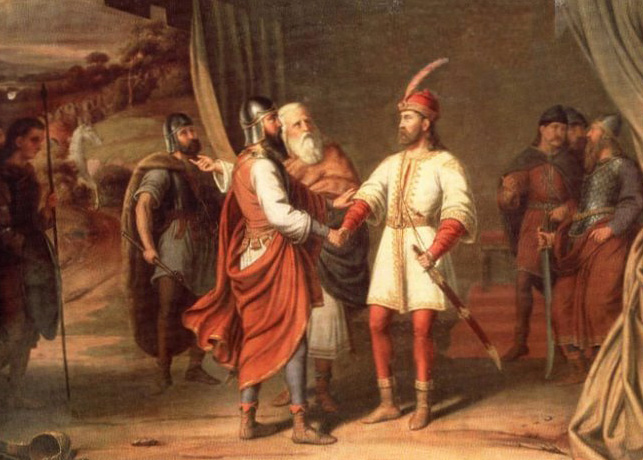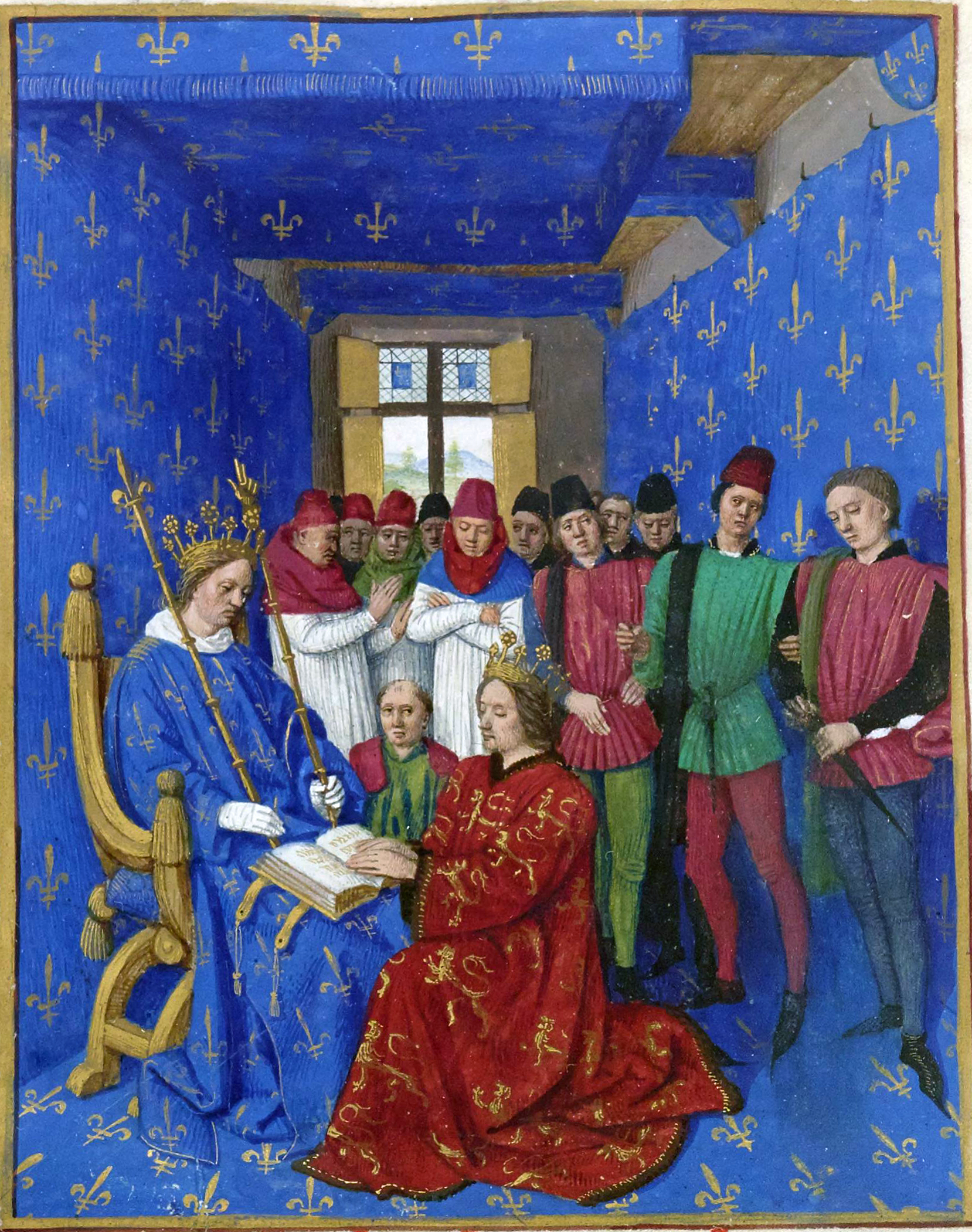|
Václav III
Wenceslaus III ( cz, Václav III., hu, Vencel, pl, Wacław, hr, Vjenceslav, sk, Václav; 6 October 12894 August 1306) was King of Hungary and Croatia between 1301 and 1305, and King of Bohemia and Poland from 1305. He was the son of Wenceslaus II, King of Bohemia, who was later also crowned king of Poland, and Judith of Habsburg. Still a child, Wenceslaus was betrothed to Elizabeth, the sole daughter of Andrew III of Hungary. After Andrew III's death in early 1301, the majority of the Hungarian lords and prelates elected Wenceslaus king, although Pope Boniface VIII supported another claimant, Charles Robert, a member of the royal house of the Kingdom of Naples. Wenceslaus was crowned king of Hungary on 27 August 1301. He signed his charters under the name Ladislaus in Hungary. His rule was only nominal, because a dozen powerful lords held sway over large territories in the kingdom. His father realized that Wenceslaus's position could not be strengthened and took him bac ... [...More Info...] [...Related Items...] OR: [Wikipedia] [Google] [Baidu] |
King Of Hungary
The King of Hungary ( hu, magyar király) was the ruling head of state of the Kingdom of Hungary from 1000 (or 1001) to 1918. The style of title "Apostolic King of Hungary" (''Apostoli Magyar Király'') was endorsed by Pope Clement XIII in 1758 and used afterwards by all Monarchs of Hungary. The term "King of Hungary" is typically capitalized only as a title applied to a specific person; however, within this article, the terms "Kings of Hungary" or "Junior Kings" (etc.) are also shown in capital letters, as in the manner of philosophical writing which capitalizes concepts such as Truth, Kindness and Beauty. Establishment of the title Before 1000 AD, Hungary was not recognized as a kingdom and the ruler of Hungary was styled Grand Prince of the Hungarians. The first King of Hungary, Stephen I. was crowned on 25 December 1000 (or 1 January 1001) with the crown Pope Sylvester II had sent him and with the consent of Otto III, Holy Roman Emperor. Following ... [...More Info...] [...Related Items...] OR: [Wikipedia] [Google] [Baidu] |
King Of Croatia
This is a complete list of rulers of Croatia under domestic ethnic and elected dynasties during the Croatian Kingdom (925–1918). This article follows the monarch's title number according to Hungarian succession for convenience. For example, the Hungarian monarch Béla IV is according to Croatian succession correctly titled Béla III. This is because Hungarians had a king named Béla prior to the incorporation of Croatia under the Hungarian Crown but the Croats did not. Early history The details of the arrival of the Croats in the Balkans are sparsely documented by reliable historical sources. Around 626 CE, Croats migrated from White Croatia (around present-day Galicia) at the invitation of the Byzantine Emperor Heraclius. According to a legend recorded in the 10th-century ''De Administrando Imperio'', the Croats came to their present region under the leadership of five brothers (called Kloukas, Lobelos, Kosentzis, Mouchlo, and Chrobatos) and of two sisters (called Touga and ... [...More Info...] [...Related Items...] OR: [Wikipedia] [Google] [Baidu] |
Gniezno
Gniezno (; german: Gnesen; la, Gnesna) is a city in central-western Poland, about east of Poznań. Its population in 2021 was 66,769, making it the sixth-largest city in the Greater Poland Voivodeship. One of the Piast dynasty's chief cities, it was the first historical capital of Poland in the 10th century and early 11th century, and it was mentioned in 10th-century sources, possibly including the Dagome Iudex, as the capital of Piast Poland. Gniezno is the seat of the Roman Catholic Archdiocese of Gniezno, the country's oldest archdiocese, founded in 1000, and its archbishop is the primate of Poland, making the city the country's ecclesiastical capital. The city is the administrative seat of Gniezno County (''powiat''). Geography Gniezno is one of the historic centers of the Greater Poland region, the cradle of the Polish state. Alike Rome, Gniezno was founded on seven hills, including the , which is the location of the Gniezno Cathedral, and the Panieńskie Hill, which is ... [...More Info...] [...Related Items...] OR: [Wikipedia] [Google] [Baidu] |
King Of Poland
Poland was ruled at various times either by dukes and princes (10th to 14th centuries) or by kings (11th to 18th centuries). During the latter period, a tradition of free election of monarchs made it a uniquely electable position in Europe (16th to 18th centuries). The first known Polish ruler is Duke Mieszko I, who adopted Christianity under the authority of Rome in the year 966. He was succeeded by his son, Bolesław I the Brave, who greatly expanded the boundaries of the Polish state and ruled as the first king in 1025. The following centuries gave rise to the mighty Piast dynasty, consisting of both kings such as Mieszko II Lambert, Przemysł II or Władysław I the Elbow-high and dukes like Bolesław III Wrymouth. The dynasty ceased to exist with the death of Casimir III the Great in 1370. In the same year, the Capetian House of Anjou became the ruling house with Louis I as king of both Poland and Hungary. His daughter, Jadwiga, later married Jogaila, the pagan Grand Du ... [...More Info...] [...Related Items...] OR: [Wikipedia] [Google] [Baidu] |
Kujavia
Kuyavia ( pl, Kujawy; german: Kujawien; la, Cuiavia), also referred to as Cuyavia, is a historical region in north-central Poland, situated on the left bank of Vistula, as well as east from Noteć River and Lake Gopło. It is divided into three traditional parts: north-western (with the capital in Bydgoszcz, ethnographically regarded often as non-Kuyavian), central (the capital in Inowrocław or Kruszwica), and south-eastern (the capital in Włocławek or Brześć Kujawski). Etymology The name Kuyavia first appeared in written sources in the 1136 Bull of Gniezno ( pl, Bulla Gnieźnieńska, Latin: ''Ex commisso nobis'') issued by Pope Innocent II, and was then mentioned in many documents from medieval times. It is also mentioned in the chronicles of Wincenty Kadłubek. Geography In the north, Kuyavia borders with the historic regions of Gdańsk Pomerania (Pomerelia) and Chełmno Land, in the west with proper (exact) Greater Poland, in the south with Łęczyca Land and in the east ... [...More Info...] [...Related Items...] OR: [Wikipedia] [Google] [Baidu] |
Greater Poland
Greater Poland, often known by its Polish name Wielkopolska (; german: Großpolen, sv, Storpolen, la, Polonia Maior), is a Polish historical regions, historical region of west-central Poland. Its chief and largest city is Poznań followed by Kalisz, the oldest city in Poland. The boundaries of Greater Poland have varied somewhat throughout history. Since the Middle Ages, Wielkopolska proper has been split into the Poznań Voivodeship (14th century to 1793), Poznań and Kalisz Voivodeship (1314–1793), Kalisz Administrative division of the Polish–Lithuanian Commonwealth, voivodeships. In the wider sense, it also encompassed Sieradz Voivodeship (1339–1793), Sieradz, Łęczyca Voivodeship, Łęczyca, Brześć Kujawski Voivodeship, Brześć Kujawski and Inowrocław Voivodeship, Inowrocław voivodeships, which were situated further eastward. After the Partitions of Poland at the end of the 18th century, Greater Poland was incorporated into Kingdom of Prussia, Prussia as the ... [...More Info...] [...Related Items...] OR: [Wikipedia] [Google] [Baidu] |
House Of Árpád
A house is a single-unit residential building. It may range in complexity from a rudimentary hut to a complex structure of wood, masonry, concrete or other material, outfitted with plumbing, electrical, and heating, ventilation, and air conditioning systems.Schoenauer, Norbert (2000). ''6,000 Years of Housing'' (rev. ed.) (New York: W.W. Norton & Company). Houses use a range of different roofing systems to keep precipitation such as rain from getting into the dwelling space. Houses may have doors or locks to secure the dwelling space and protect its inhabitants and contents from burglars or other trespassers. Most conventional modern houses in Western cultures will contain one or more bedrooms and bathrooms, a kitchen or cooking area, and a living room. A house may have a separate dining room, or the eating area may be integrated into another room. Some large houses in North America have a recreation room. In traditional agriculture-oriented societies, domestic animals such as ... [...More Info...] [...Related Items...] OR: [Wikipedia] [Google] [Baidu] |
Oligarch (Kingdom Of Hungary)
An oligarch or provincial lord ( hu, tartományúr; formerly the term ''petty king'' was also used) was a powerful lord who administered huge contiguous territories through usurping royal prerogatives in the Kingdom of Hungary in the late 13th and early 14th centuries. List of oligarchs Interregnum (1301–1310) * Amadeus Aba ( Northeast Hungary) * Stephen Ákos ( Borsod) * Stephen Babonić ( Lower Slavonia) * James Borsa ( Transtisia) * Matthew Csák ( Northwest Hungary) * Ugrin Csák ( Upper Syrmia) * Dujam Frankopan ( Primorje) * Ladislaus Kán (Transylvania) * Henry Kőszegi ( Southern Transdanubia and Upper Slavonia) * Ivan Kőszegi (Western Transdanubia) * Stephen Dragutin Nemanjić ( Lower Syrmia) * Nicholas Pok ( Szamosköz) * Dominic Rátót (Nógrád) * Paul Šubić (Croatia , image_flag = Flag of Croatia.svg , image_coat = Coat of arms of Croatia.svg , anthem = "Lijepa naša domovino"("Our Beautiful Homeland") , ... [...More Info...] [...Related Items...] OR: [Wikipedia] [Google] [Baidu] |
Kingdom Of Naples
The Kingdom of Naples ( la, Regnum Neapolitanum; it, Regno di Napoli; nap, Regno 'e Napule), also known as the Kingdom of Sicily, was a state that ruled the part of the Italian Peninsula south of the Papal States between 1282 and 1816. It was established by the War of the Sicilian Vespers (1282–1302), when the island of Sicily revolted and was conquered by the Crown of Aragon, becoming a separate kingdom also called the Kingdom of Sicily. In 1816, it reunified with the island of Sicily to form the Kingdom of the Two Sicilies. The territory of the Kingdom of Naples corresponded to the current Italian regions of Campania, Calabria, Apulia, Basilicata, Abruzzo, Molise and also included some areas of today's southern and eastern Lazio. Nomenclature The term "Kingdom of Naples" is in near-universal use among historians, but it was not used officially by the government. Since the Angevins remained in power on the Italian peninsula, they kept the original name of the Kingdom ... [...More Info...] [...Related Items...] OR: [Wikipedia] [Google] [Baidu] |
Pope Boniface VIII
Pope Boniface VIII ( la, Bonifatius PP. VIII; born Benedetto Caetani, c. 1230 – 11 October 1303) was the head of the Catholic Church and ruler of the Papal States from 24 December 1294 to his death in 1303. The Caetani, Caetani family was of baronial origin, with connections to the papacy. He succeeded Pope Celestine V, who had papal resignation, abdicated from the papal throne. Boniface spent his early career abroad in diplomatic roles. Boniface VIII put forward some of the strongest claims of any pope to temporal as well as spiritual power. He involved himself often with foreign affairs, including in France, Sicily, Italy and the First War of Scottish Independence. These views, and his chronic intervention in "temporal" affairs, led to many bitter quarrels with Albert I of Germany, Philip IV of France, and Dante Alighieri, who placed the pope in the Eighth Circle of Hell in his ''Divine Comedy'', among the simony, simoniacs. Boniface systematized canon law (Catholic Church), ... [...More Info...] [...Related Items...] OR: [Wikipedia] [Google] [Baidu] |





